When Steve Jobs unveiled the first iPad in 2010, only one thought entered my mind. “Wow, imagine reading music on something like that.” 3 years and 1 iPad later, my inquisitive imagine has been sated.
I should mention that during these 3 years, I found it difficult to envision a future where I use a tablet to read music; there were too many variables and not much has been written or documented about this process. I hope to change that with this article.
The Short Version
If you wondering if it is possible to read complicated, high-level classical music notation on a 9.7 inch iPad, the simple answer is yes, provided that you are willing to convert your existing material to a pdf file and you can make do with the reduced real estate.
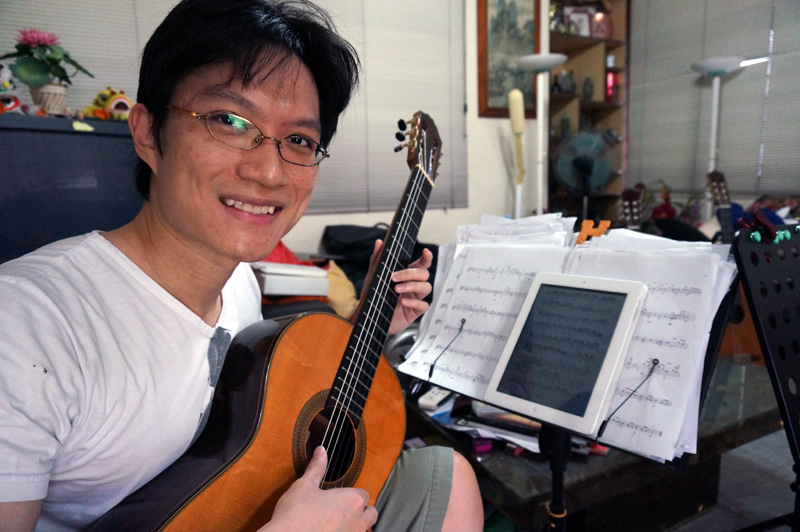
By my estimates, the reading area of the iPad is around 30% smaller compared to an A4-sized of paper. Compared to some music books, it is even smaller.
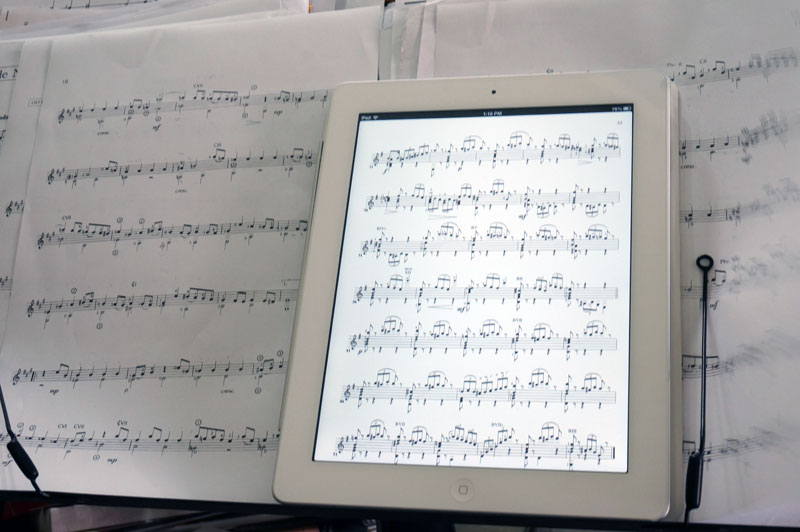
Retina makes a difference
Despite the smaller reading area, the incredible sharpness offer by Apple’s Retina display makes reading complicated material feasible. It took me a while to get used to it, but after 3 months of usage, I am now able to sight read grade 8 material (or its equivalent) on my iPad. Honestly, I have not tried to read even more complicated concert material on my iPad, but I imagine that the experience won’t differ too much. What the iPad lacks in size, it makes up for in its incredible sharpness.
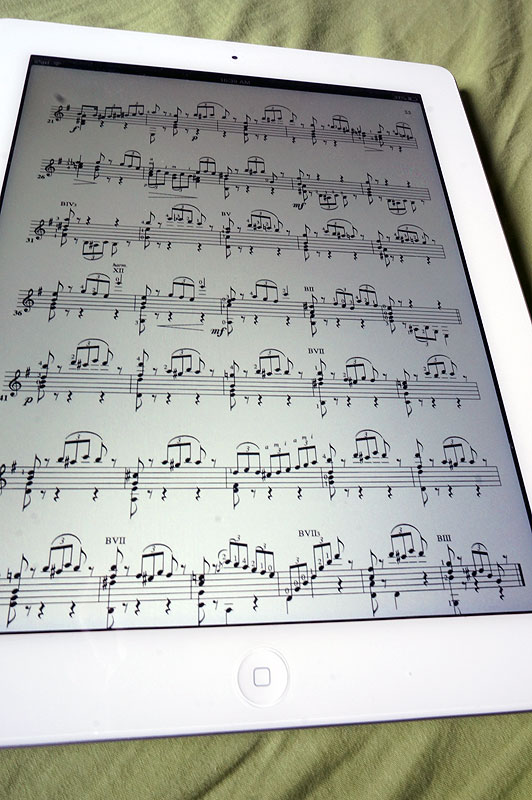
You may think that purchasing a larger Android tablet may solve the problem of the smaller screen size. I considered that too, so before investing in an iPad, I considered buying the 13 inch Toshiba Excite tablet, but there is a reason why I didn’t.
iOS vs Android
During my search for a suitable tablet, I considered a variety of Android-powered tablets. But whenever I read a review on an Android tablet, I always encountered the same criticism: Android’s tablet ecosystem pales in comparison to iOS.
From my experiences with Android tablets, using pdf readers was out of the question. They are slow and clunky compared to the responsiveness and fluidity of the iPad. Under no circumstances did I want to see the dreaded ‘checkered flag’ loading image during a page turn. But if we are comparing pdf readers, the iPad also wins hands-down. It’s not even close. The iPad is much more fluid and responsive than any Android tablet I’ve tried, with virtually no lag or loading screens. I also believed in the value of a music reading app instead of merely using a pdf reader.
With its superior ecosystem and user experience, the iPad was the clear winner.
Also, I prefer the way the iPad functions compared to Android. Aside from the highly optimised experience mentioned above, iOS’s more discreet handling of notifications makes reading music more immersive with fewer distractions. Android is a bit too liberal with its notifications, which can be a both irritating and distracting when you are trying to seriously get into the material. Imagine getting tons of notifications from facebook or twitter as you attempt to read complex material.
forScore – my preferred music reading app
My preferred music reading app is ‘forScore’, which is currently an iPad exclusive. I tried a few other music reading apps, but forScore was the one that worked best for my needs.
forScore is much better at annotating sheet music than a dedicated tablet/stylus solution like the Galaxy Note. In fact, when I tried the Galaxy Note 10.1, I was surprised at how cumbersome it was to edit my material despite the inclusion of a stylus. Honestly, editing on forScore isn’t as fast or convenient as putting pencil to paper, but it’s usable. forScore also has a host of other handy features like a half-page turns and meta data that makes it easy for me to organize my library. This makes searching for material faster and more convenient. The moment I found the material I needed through a simple search, I wanted to digitize my entire library.
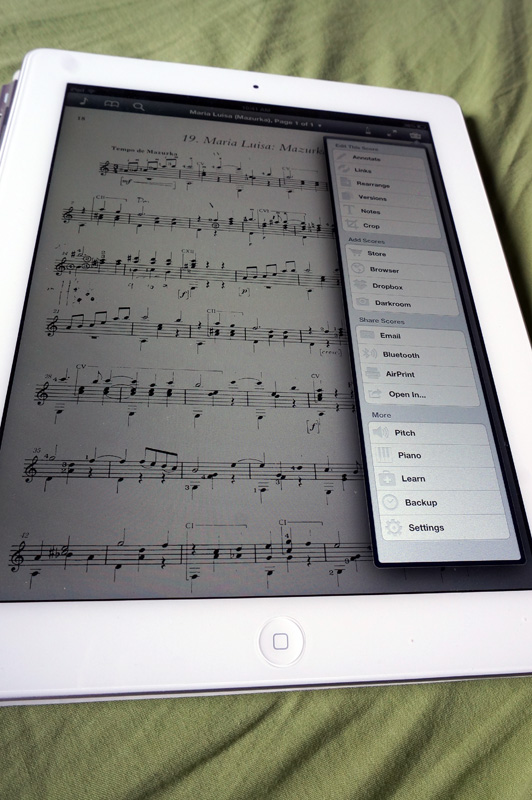
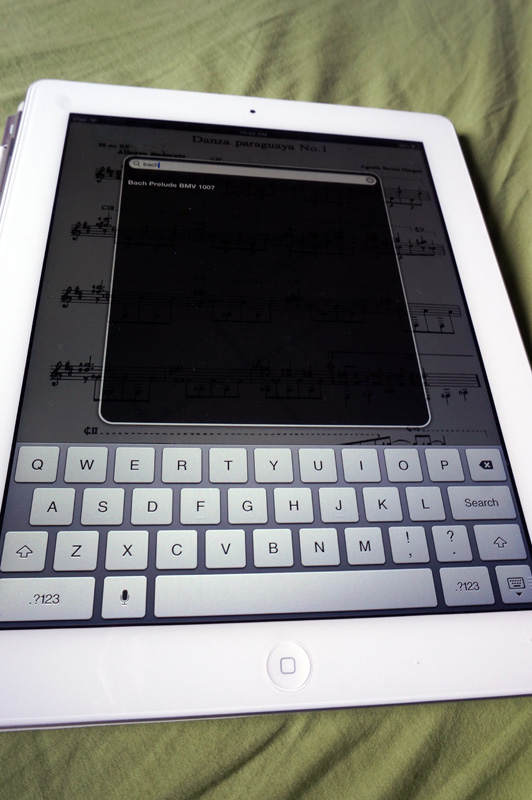
There are other options out there and I did not look at all of them, but I didn’t need to. I found what works for me. And at least the iPad has options. Android has a sparse tablet ecosystem and I wasn’t going to invest in a tablet and hope that the situation gets better. I needed something that meets my needs now, and forScore and the iPad was it.
If I wanted to gamble, I’d rather spend the money on Toto.
Closing Words
When I was buying my iPad, I justified my purchase by telling myself that if the music reading thing doesn’t work out, I would still be able to use the iPad for other things. And make no mistake, the iPad excels as a media consumption device. I do everything from surfing the web, to checking e-mail, to updating my calendar, to reading comic books, magazines and newspapers on my iPad.
As cliché as it sounds, it just works, and it works exceptionally well.
Fortunately, I did not have relegate the iPad as a media consumption device. It also performs well as a music reader. It isn’t perfect. I wish the iPad offered more screen real estate and I wish editing was easier and faster (especially for changing fingerings) but I’m nitpicking at this point.
I am reasonably convinced that my music reading experience would be less satisfactory if I bought an Android or Windows 8 tablet . I may have only used my iPad for 3 months, but the more I use it the more convinced I am that I want to read all my music on it.
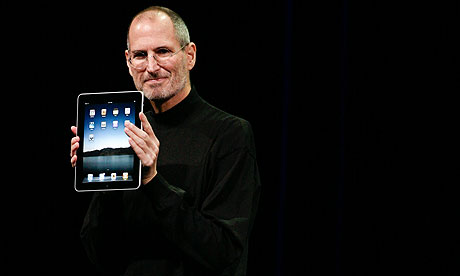
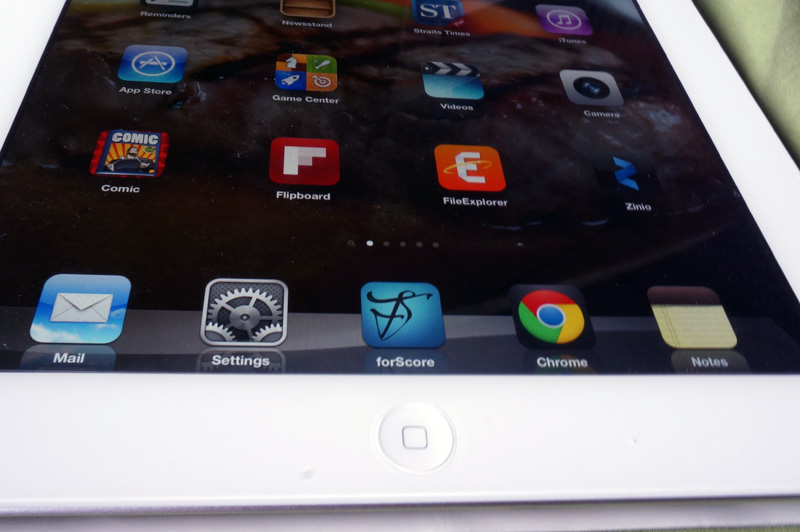
Hi Dedrick! Fantastic article! I have a few questions – I’m considering digitising all my music as well.
1. Is 16gb enough, for both a digital library and “a normal life” on the iPad? – How much storage do you have? And do you use the feature in forScore where you link certain peaces of music in your iTunes library to sheet? Do you think 16gb is enough for all that?
2. How far away from your eyes is your iPad when you’re playing and reading? Can you justify the relatively small screen-size by simply placing it closer?
3. Is it at all, possible to read scores? (In my case, I would be using it to read big band scores)
Cheers!
John Riddell
Hi John,
Thanks for reading, I’m glad you enjoyed the article.
Prior to buying my iPad, I have never owned a tablet before. I bought the 32GB iPad because I was thinking, “well I don’t have THAT much music notation, and how much storage am I really going to need anyway? I’m not going to load any music (mp3s) or videos on this.”
1 month and several apps and shelves worth of sheet music later, I was left with less than 10GB. There was no way the 32GB iPad had enough storage to last me another 2-3 years. Less than a month later, I gave my iPad to mum and bought the 128GB iPad. As a musician who needs the iPad for work, it was a no-brainer.
That being said, “normal” is very subjective term. I’m sure some could get away with only 16GB, but my advice is to buy the largest storage you can afford. Mum loves her 32GB iPad and still has plenty of storage left.
I do not link my forScore music to anything in iTunes, because as mentioned previously, I do not load any music on my iPad.
I am able to read A4-scans of music on my iPad from about an arms-length away. I place my iPad on the music stand where I read printed scores. I do not move closer simply because I am using an iPad. However, I must say that the smaller size took some getting used to.
I am able to read fairly complex grade 8 material (or its equivalent), with plenty of 6-note chords written entirely in musical notation. I have also used it to read some chamber music, including trio and quartet work.
All this being said, my eyesight, ability to read from a smaller surface area and reading material is different from yours. Your experience could be worse or even better than mine. I advise you to look at some of your material on an iPad to see how comfortable you are with it. Using an iPad to read music is definitely an idea worth considering, especially with the new and considerably lighter iPad Airs, which are REALLY attractive for musicians looking to bring their entire library with them in a compact and light package.
Thank you so much for this Dedrick.
Could you please update as of August 2014.
I am looking also at A4 tablets. Have you done likewise?
I am wondering what your views are now.
Would appreciate your feedback…. or anyone else’s.
I want to move my scores onto one music reading device.
Since I’ve written this article, the only tablet to have really caught my interest is the Microsoft Surface. Having a tablet with laptop-like internals means that I could use it to read music while recording from a audio interface with condenser microphone – all from the comfort of my music stand!
Samsung has also launched a 12 inch Galaxy Note Tablet, but I’d prefer to steer clear of Android tablets for now. The app ecosystem for tablets is still HORRIBLE and it isn’t as reliable as iOS or Windows.
If Apple launches the much rumoured 12 inch iPad, it would be a great boon to musicians everywhere.